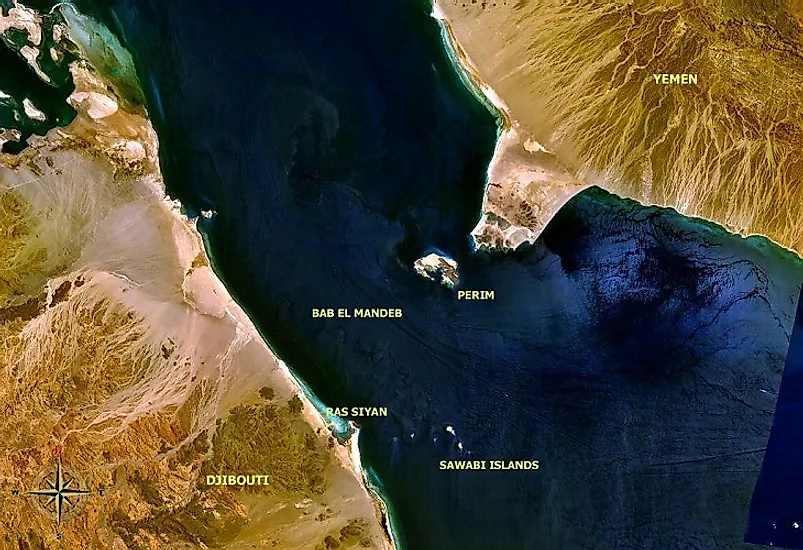Where Is The Bab El-Mandeb Strait?

5. Description
The Bab el-Mandeb Strait is a strait of great strategic and economic importance, connecting the Red Sea in the northwest to the Gulf of Aden and the Indian Ocean in the southeast. The strait also separates Arabia in the northeast from the African continent in the southwest. The Bab el-Mandeb further acts as a link between the Indian Ocean and the Mediterranean Sea via the Red Sea and the Suez Canal.The strait is divided into two channels by the Yemeni island of Perim, with the eastern channel being called Alexander’s Strait and is around 3 kilometers wide, while the western-lying Dact-el-Mayun Channel is 26 kilometers wide.
4. Historical Role
It is believed that in the ancient world, the strait of Bab el-Mandeb was much shallower than what it is today, allowing the earliest migrations of modern humans across the strait. As per local knowledge, it is possible that the strait served as the route of entry of the Semitic Ge'ez speakers into Africa some time around 1900 BC. In the period between 100 and 940 AD, the Aksumite Empire ruled over the region of what is now Eritrea and Northern Ethiopia, and held the Bab el-Mandeb under their control. In 1799, the Perim Island on the strait was captured by the British, who subsequently erected a lighthouse on the island in 1861, allowing the British to exert their influence on the strategic trade routes along the Bab el-Mandeb. The name of the strait, Bab el-Mandeb, means the “Gate of Tears” in Arabic, referring to the large number of shipwrecks that have occurred in this region. Arabian legends also talk about the large-scale drowning of people in the waters of the Bab el-Mandeb during the earthquake that separated the landmasses of Arabia from Ethiopia.
3. Modern Significance
The Bab el-Mandeb serves as a strategic oil trade route between the Middle East and the European countries. It allows a direct connection between the Persian Gulf and the Mediterranean Sea via the Suez Canal. Closure of this strait would thus force the oil tankers from the Persian Gulf to navigate all the way across the southern tip of Africa towards the north to reach the countries of the European Union, costing huge losses in terms of time and money. Besides oil, the strait also serves as a navigation route for non-oil vessels moving between the Middle East and Mediterranean countries. Currently, a bridge, prospectively to be named as the ‘Bridge of Horns’, has been proposed to be built on the Bab el-Mandeb Strait between the coasts of Yemen and Dibjouti.
2. Habitat and Biodiversity
The Bab el-Mandeb supports the Eritrean Coastal Desert eco-region along its shores. The climate of the region is hot and dry, with less than 100 millimeters of precipitation falling annually there. Temperature maximums of 33° Celsius are possible, though conditions closer to the mean temperature of 27° Celsius prevails in the region. The landscape of the coastal area in this eco-region is made up of sand- and gravel-covered flatlands, with rocky outcrops and some old coral reefs being found along the shoreline. Not much biodiversity is supported in this habitat. Dorcas gazelles, Soemmerring’s gazelles, and Salt’s dikdiks are some of the common species of this ecosystem. The Bab el-Mandeb Strait and the adjacent Red Sea region, however, witnesses some large-scale bird migrations of birds, such as those of steppe eagles and steppe buzzards in the autumn season. Grassland steppes, herbs, and shrubs comprise the vegetation of coastal areas, and some species of halophytic plants also grow along the shores. Human populations in this eco-region are sparse, and mostly limited to small fishing villages along the shorelines.
1. Environmental Threats and Territorial Disputes
Both environmental and territorial threats dominate the region surrounding the Bab el-Mandeb Strait. The poaching of gazelles, nesting seabirds, and threatened turtle species in the Eritrean Coastal Desert eco-region threatens the survival of these animals. Also, the future threat of developmental activities along the coastline and overgrazing by livestock kept by the growing human population also threatens the habitat of the region. Besides ecological threats, safety and security of foreign firms active in the Bab el-Mandeb region is also an area of major concern. The waterway through the strait has been exploited by several political forces in the past as a weapon to cause financial losses to their enemies. During the Yom Kippur War, the Egyptian forces completely blocked the import and export of goods from Israel by closing down the Bab el-Mandab strait. In 2002, a French tanker was attacked by terrorists off the coast of Yemen. Yemen also uses the water route of the strait for trading its oil and petroleum produce, and any barriers to free movement across this strait would spell a financial disaster for Yemen, and also affect oil and petroleum prices worldwide.











